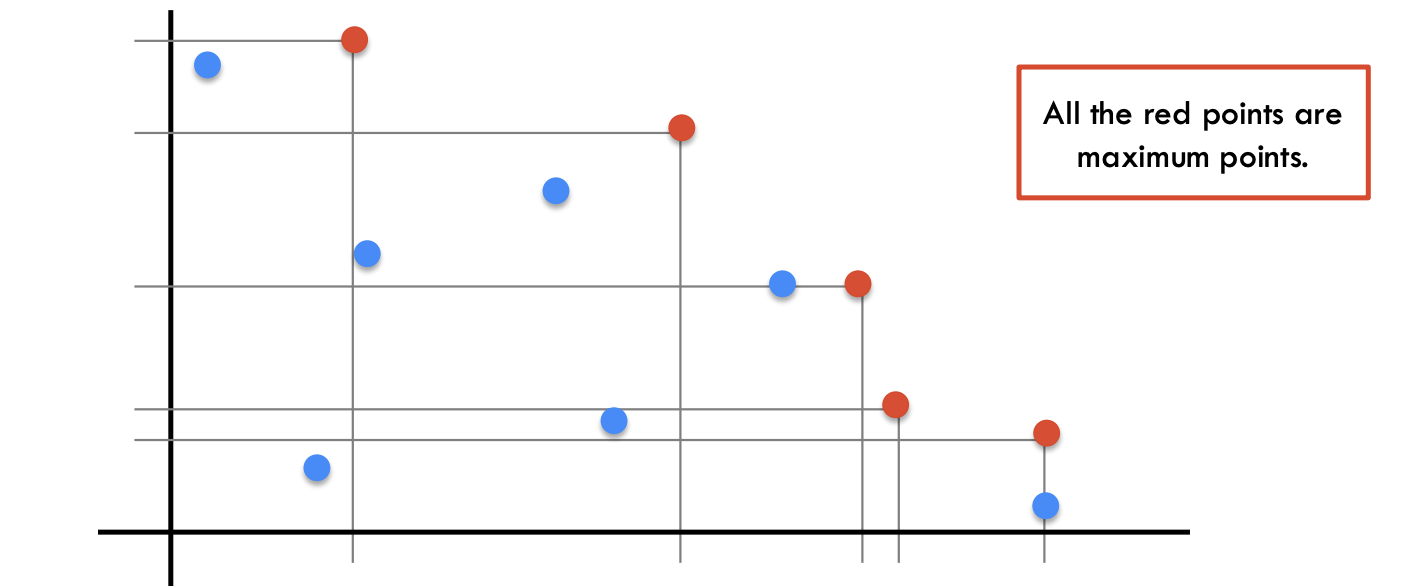Related paradigm:
Algorithm Divide_and_Conquer Maxima_Set
Maxima set problem is to identify the set of maximum points in a 2D plane.
Definition: A point is maximum in a set if all other points in the set have either a smaller x or smaller y coordinate.
Problem:
Given a set S of distinct points in the plane, find the set of all maximum points.

This problem can be solved using divide and conquer paradigm for better runtime time efficiency.
- Preprocessing
- Sort the points by increasing x coordinate and store them in an array or list. This ensures when dividing the points, the left sub list contains points with smaller x-coordinates, and right sub list contains with larger x-coordinates.
- Divide
- Split the sorted list into two halves, let be the left half and be the right half
- Conquer
- Recursively find the maxima set for and
- Base case is reached when the input list has only one point, it is returned as is because a single point is trivially a maxima
- Merge
- Find the highest point in the (point with the maximum y-coordinate) by sorting the list by their y-coordinate.
- Each point in the is compared with the highest point in the . If a point in the left set has a greater y-coordinate (higher than the highest point in the right set), the point is included in the resulting list.
- Finally, all points from the are added to the resulting list.
Implementation
Given a 2D plane with points allocated, the points in red are the resulting maxima points.

/* This implementation assumes the points are added in ascending order of their x coordinate */
public static void main(String[] args) {
List<Point> points = new ArrayList<>();
points.add(new Point(1, 6)); //A
points.add(new Point(3, 2)); //B
points.add(new Point(4, 7)); //C
points.add(new Point(5, 4)); //D
points.add(new Point(7, 5)); //E
points.add(new Point(8, 3)); //F
List<Point> maxima = findMaxima(points);
for (Point pt : maxima) {
System.out.println(pt);
}
}
public static List findMaxima(List<Point> input) {
if (input.size() <= 1) {
return new ArrayList(input);
}
int mid = input.size()/2;
List<Point> left = new ArrayList<>(input.subList(0, mid));
List<Point> right = new ArrayList<>(input.subList(mid, input.size()));
// recursively find maxima in the left and right set
List<Point> leftMaxima = findMaxima(left);
List<Point> rightMaxima = findMaxima(right);
return merge(leftMaxima, rightMaxima);
}
public static List<Point> merge(List<Point> left, List<Point> right) {
List<Point> mergedSet = new ArrayList<>();
Collections.sort(right, Comparator.comparingInt(Point::getY));
Point highestPtInRight = right.get(right.size()-1);
// if any point in the left is higher than the highest point in the right
// add it to the resulting list
for(Point pt : left) {
if (pt.getY() > highestPtInRight.getY()) {
mergedSet.add(pt);
}
}
// add all points in the right to the resulting list
mergedSet.addAll(right);
return mergedSet;
}
}Correctness
The input is divided into two halves and , since every point in the original set is either in the left or right half, any point in the overall maxima set must be in either or . The highest point in the right set has the maximum y coordinate among all points in the right set. By comparing each point in the left set with the highest point in the right set , if a point in has greater y coordinate value, then the point is not dominated by this highest point, which can be further concluded it is not dominated by any other point in the because no other point in the right set has a higher y coordinate value.
Time complexity
The algorithm time complexity can be analysed using master theorem.
- Divide the problem
- The input list is divided into 2 halves (), each of size ().
- Combine the result
- The merge step involves combing the results from left and right halves, the operation takes time as it involves sorting and linear scan ().
Given the master theorem for divide and conquer in general form: From the evaluated result:
We can obtain the resulting expression: Analyse the master theorem equation:
- Non-recursive part growth rate: ,
- Recursive part growth rate:
The non-recursive part and recursive part have the same growth rate since . The overall time complexity is:
Back to parent node: Divide and Conquer